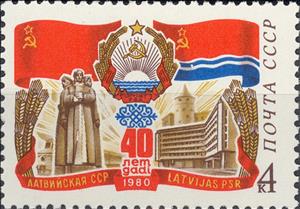Stamp: 40th Anniversary of Latvian SSR. (Soviet Union, USSR 1980)
40th Anniversary of Latvian SSR. (Soviet Union, USSR 1980)
21 July (Soviet Union, USSR ) within release 40th Anniversary of Estonian SSR. goes into circulation Stamp 40th Anniversary of Latvian SSR. face value 4 Russian kopek
| Stamp 40th Anniversary of Latvian SSR. in catalogues | |
|---|---|
| Michel: | Mi:SU 4976 |
Stamp is horizontal format.
Also in the issue 40th Anniversary of Estonian SSR.:
- Stamp - 40th Anniversary of Latvian SSR. face value 4;
- Stamp - 40th Anniversary of Estonian SSR. face value 4;
Stamp 40th Anniversary of Latvian SSR. it reflects the thematic directions:
A flag is a piece of fabric (most often rectangular or quadrilateral) with a distinctive design that is used as a symbol, as a signaling device, or as decoration. The term flag is also used to refer to the graphic design employed, and flags have since evolved into a general tool for rudimentary signalling and identification, especially in environments where communication is similarly challenging (such as the maritime environment where semaphore is used). National flags are patriotic symbols with varied wide-ranging interpretations, often including strong military associations due to their original and ongoing military uses. Flags are also used in messaging, advertising, or for other decorative purposes. The study of flags is known as vexillology, from the Latin word vexillum, meaning flag or banner.
A monument is a type of structure that was explicitly created to commemorate a person or event, or which has become relevant to a social group as a part of their remembrance of historic times or cultural heritage, due to its artistic, historical, political, technical or architectural importance. Examples of monuments include statues, (war) memorials, historical buildings, archaeological sites, and cultural assets. If there is a public interest in its preservation, a monument can for example be listed as a UNESCO World Heritage Site. The Palgrave Encyclopedia of Cultural Heritage and Conflict gives the next definition of monument:
A symbol is a mark, sign, or word that indicates, signifies, or is understood as representing an idea, object, or relationship. Symbols allow people to go beyond what is known or seen by creating linkages between otherwise very different concepts and experiences. All communication (and data processing) is achieved through the use of symbols. Symbols take the form of words, sounds, gestures, ideas, or visual images and are used to convey other ideas and beliefs. For example, a red octagon is a common symbol for "STOP"; on maps, blue lines often represent rivers; and a red rose often symbolizes love and compassion. Numerals are symbols for numbers; letters of an alphabet may be symbols for certain phonemes; and personal names are symbols representing individuals.



